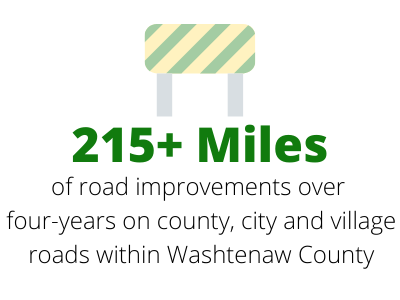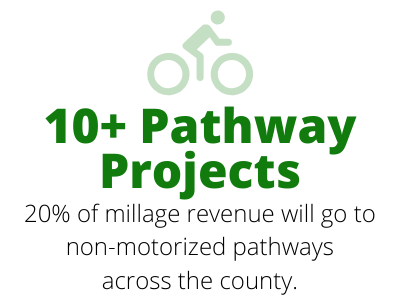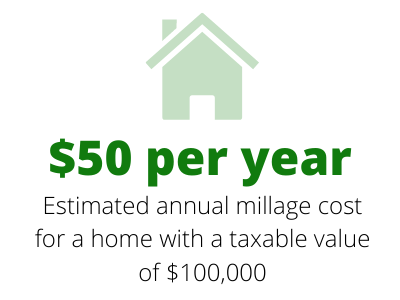In 2020, voters of Washtenaw County renewed the four-year County-Wide Roads and Non-Motorized Millage. This 0.5 mill property tax is levied in each winter tax bill of the millage years (2020, 2021, 2022 and 2023). Money collected is invested into road and non-motorized projects in the construction season that immediately follows. Check out the map and links below for more information.
Click here for a printer-friendly project map.



Frequently Asked Questions
Which roads will be repaired?
WCRC has partnered with local cities and villages to create a four-year road improvement plan that outlines which projects will be completed each year the millage is levied. Check out the links and interactive map above.
Millage revenues will be used to improve roads across the county through a variety of treatments including, reconstruction, paved and unpaved road resurfacing, seal coat (chip seal). Projects have been selected based on expected needs of the road system.
When will road work begin?
Road work funded by this millage began in the spring of 2021 and will take place each construction season between 2021 – 2024.
The millage will be levied on Washtenaw County resident’s winter tax bill each year and those funds are put into road improvements the following spring/summer.
How is the revenue generated by the millage divided?
Just like the 2017- 2020 millage, all revenue generated by the millage stays in Washtenaw County. The millage is estimated to generate approximately $8.9 million per year for Washtenaw County roads and non-motorized paths.
- WCRC will receive approximately $4 million per year to fund road work in the county’s twenty townships.
- Cities and villages will receive approximately $3.1 million per year, with specific allocations based on the amount raised within a municipality’s borders. For example, the City of Ann Arbor will receive approximately $2.4 million per year to invest in their roads and pedestrian facilities.
- The Washtenaw County Parks & Recreation Commission will receive approximately $1.8 million per year to support the expansion of the county’s non-motorized path network.
How is this millage different from Ann Arbor’s street millage?
The county-wide, four-year road and non-motorized millage funds road improvements in every city, village, and township throughout Washtenaw County.
Ann Arbor’s five-year street millage, levied only on property owners within city limits, funds improvements within the City of Ann Arbor’s borders. The city’s millage does not fund any improvements to the 1,650 miles of county roads, including many commuter roads into Ann Arbor, such as Huron River Drive, Pontiac Trail, and Geddes Road.
I understand that the state approved a road funding package in 2015. Why isn’t that enough to fix Washtenaw County’s roads?
Michiganders have underinvested in the road system for decades. That means, once the state legislature’s increase to the state fuel tax and registration fees finally took effect in 2017, there was a massive hole to dig out of for the road system. The increased state revenues and the first County Road and Non-Motorized Millage (2017-2020) helped but Washtenaw County still faces tremendous needs for its 1,650-mile road system. Click here to explore current pavement condition ratings for Washtenaw County.
The 2021 – 2024 Roads and Non-motorized Millage will help to improve more than 215 miles of roads in Washtenaw County over a four-year period. These roads couldn’t be improved as quickly without this local funding source.
The problems facing Michigan’s roads is so large that it will take a variety of funding sources including federal, state and local money to improve road conditions.
How are the non-motorized funds spent?
The Washtenaw County Parks & Recreation Commission receives 20% of the revenue generated by the millage (approximately $1.8 million per year). This money is divided annually between investments in the Border-to-Border (B2B) trail system and funding for the Connecting Communities Grant Program.
The B2B is a non-motorized pathway that connects cities, parks, and many destinations throughout Washtenaw County. Within the county, 35 miles are complete and 19 more miles are planned. Millage funds for the B2B go directly to construction and so far have been used to leverage more than $11 million in grant funding and private donations.
The Connecting Communities Grant Program provides supplemental funding to assist municipalities with the development of locally important non-motorized projects. Millage funds are used to help with a variety of project expenses, with an emphasis on construction and engineering costs.
How much will this millage cost me?
This 0.5 mill millage would be assessed on your winter property tax bill in 2020, 2021, 2022 and 2023. The amount owed will depend on the taxable value of your home.
For example, if the taxable value of your home is $100,000, a 0.5 mill will cost approximately $50 per year.
(Property tax levied on property = (0.5 x taxable property value) ÷ 1,000)
What is the ballot language?
On April 8, 2020, the Washtenaw County Board of Commissioners approved the following ballot language that appeared on the August 4, 2020 ballot:
“Shall the limitation on the amount of taxes which may be imposed each year for all purposes on real and tangible personal property in Washtenaw County, Michigan be increased as provided in Section 6, Article IX of the Michigan Constitution and the Board of Commissioners of the County be authorized to levy a tax not to exceed one half of one mill ($0.50 per $1,000 of state taxable valuation) for a period of four (4) years, beginning with the December 1, 2020 tax levy (which will generate estimated revenues of $8,990,680.00 in the first year), to provide funding to the Washtenaw County Road Commission, Washtenaw County Parks and Recreation Commission, and the various cities, villages, and townships of Washtenaw County to maintain, construct, resurface, reconstruct or preserve roads, bike lanes, streets and paths in Washtenaw County? Of the 0.5 mill, 0.4891 represents a renewal of that portion of a 0.5 mill authorization previously approved by the electors as reduced by operation of the Headlee Amendment, and 0.0109 represents new millage in the amount equal to the amount reduced by operation of the Headlee Amendment.”
What does ``renew and restore`` mean?
The first roads and non-motorized millage rate was approved by voters in 2016 but the actual rate levied has fluctuated each year due to the State of Michigan’s Proposal A (Headlee Amendment) which limits property tax increases to the inflation rate. Although voters approved a 0.5 millage in 2016, the actual amount collected has fallen to 0.4891 mill over the years because of restrictions based on Proposal A.
Since voters approved the millage on August 4, 2020, the rate will be RESTORED again to 0.5 mill in 2020 but will gradually decrease again over the years as the Proposal A restrictions are applied.


